Many of us like to train at home due to our busy schedules and convenience when traveling. During that time, resistance bands were helpful to us.
Resistance bands have a valuable technique for maximizing muscle variability and taking strength-toning gains to new levels in our training programs. They are also a great way to build strength and tone your arms.
Confused as to where to start?
DON’T WORRY. There are many effective bicep workouts with resistance band exercises, such as bicep curls and hammer curls. Work the bicep muscles to make them stronger and more toned.
Here, I will share with you the best band bicep exercises (based on science and experience), a sample workout routine, and tips.
Want to take your gains to the next level? Discover your daily calorie needs with our free TDEE calculator

- How Resistance Band Train Bicep
- 7 Best Bicep Exercises With Resistance Band
- 1. Standing Resistance Band Curl
- 2. Band Hammer Curl
- 3. Band Concentration Curl
- 4. Reverse Grip Resistance Band Curl
- 5. Band Drag Curl
- 6. Resistance Band Seated Row
- 7. Band Assisted Pull Up
- At-Home Resistance Band Bicep Workout Plans
- Band Bicep Training Plan
- Band Bicep Workout Routine For Beginner
- Band Workout Routine For Intermediate
- Conclusion
- Know More Resistance Band Exercises
- References
How Resistance Band Train Bicep
A resistance band bicep workout uses the band’s tension to train the bicep muscles. It forces the muscles to work harder, causing microtears and muscle fatigue. This process helps the body repair and grow muscles over time.
Resistance bands create tension in an exercise’s concentric and eccentric phases. This means you experience resistance when contracting the muscle (concentric phase) and lengthening it (eccentric phase).
- The concentric phase involves muscle shortening, like lifting the band during a bicep curl.
- The eccentric phase is when the muscle lengthens, such as lowering the band back down.
Think of stretching a rubber band—it resists and tries to return to its original shape. Similarly, resistance bands provide steady resistance as you stretch them.
The best resistance band bicep exercises are bicep curls, hammer curls, and bent-over rows.
7 Best Bicep Exercises With Resistance Band
Resistance bands are a versatile and effective tool for bicep workouts. They offer unique advantages you can’t get from dumbbells, barbells, or cable machines alone.
1. Standing Resistance Band Curl
If you’re looking for straightforward bicep band exercises to add to your routine, bicep curls are a great staple exercise to get you started.
Resistance bands bicep curl keep the muscles in tension throughout the movement. This means that you will get more out of each repetition of the bicep exercise.
It’s a versatile exercise that can be done anywhere, so it’s a good choice for working out at home or on the go.
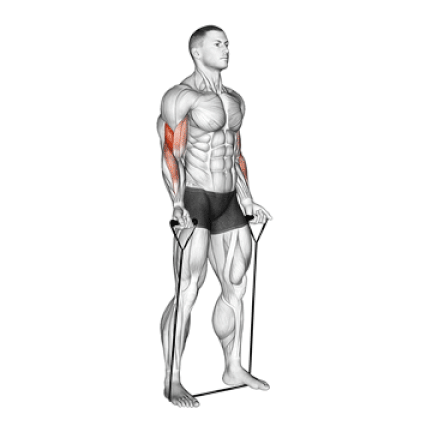
How To Do
- Stand with your feet shoulder-width apart in the middle of the resistance band.
- Hold the resistance band handles with your palms facing forward and your arms extended down by your sides.
- Slowly curl your hands up towards your shoulders.
- Squeeze your biceps at the top of the curl.
- Slowly lower your hands back down to the starting position.
- Perform 3–4 sets of 10-15 reps for best results.
2. Band Hammer Curl
The band hammer curl is a variation of the traditional hammer curl that uses resistance bands instead of dumbbells.
When it comes to building massive biceps and forearms, the hammer curl is an effective isolation workout that targets the bicep, brachialis and brachioradialis.
This exercise works the wrist and forearm muscles more than traditional bicep curls, improving grip strength and size.
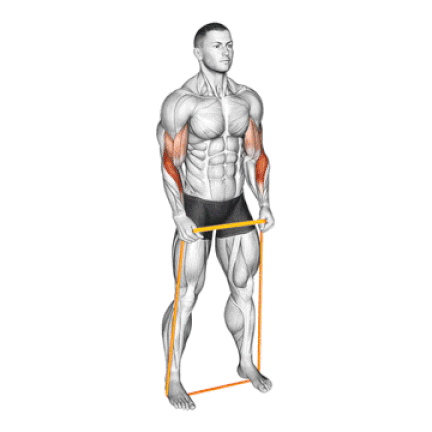
How To Do
- Stand in the middle of the resistance band with your feet shoulder-width apart.
- Grasp the ends of the resistance band with your palms facing each other (neutral grip).
- Keep your elbows close to your sides and curl your hands up towards your shoulders.
- Squeeze your biceps at the top of the curl.
- Slowly return your hands to the starting position.
- Start with three sets of 10–12 reps, then repeat for the desired number of sets.
3. Band Concentration Curl
The concentration curl is well-known for its ability to focus on and isolate the biceps brachii muscle. It strengthens the mind-muscle connection, so you can focus on the biceps and make them work as hard as possible.
Cheating? Not a chance: Because of your stable position, it’s much harder to use momentum or swing your body. This means your bicep is doing all the work, which is exactly what you want!
The band concentration curl works only one arm at a time, so it is helpful to find and correct any differences in strength between your left and right arms.

How To Do
- Sit on a bench or chair with your feet flat on the floor, and place the resistance band under your feet.
- Hold one end of the resistance band with your right hand and place your left hand on your left knee for support.
- Keep your back straight, shoulders relaxed, and your right arm fully extended with a band under your feet.
- Exhale and curl the resistance band upward towards your right shoulder. Go through the full range of motion for a deep biceps stretch.
- Pause at the top of the movement and squeeze your biceps.
- Slowly lower the resistance band back down to the starting position.
- Repeat the steps with your other arm.
4. Reverse Grip Resistance Band Curl
The reversal curl is an essential part of band bicep workouts. It is a variation of the traditional biceps reverse curl exercise that targets the brachialis and brachioradialis muscles and the biceps brachii.
The reverse curl targets the outer upper arm and forearm muscles, whereas the regular biceps curl targets more of the front of the upper arm.
It’s characterized by a unique hand position with your palms facing down (pronated grip) instead of the traditional palms-up grip. This exercise specifically targets the brachialis and the outer head of the biceps brachii.
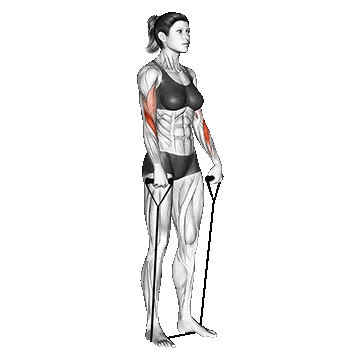
How To Do
- Stand with your feet shoulder-width apart. Maintain an upright posture. Avoid excessive leaning.
- Hold a resistance band in each hand with a reverse grip (palms facing down).
- Keep your elbows close to your sides and curl your hands up towards your shoulders.
- Pause at the top of the movement and squeeze your biceps.
- Slowly return your hands to the starting position.
- Exhale as you lift the band (the concentric phase) and inhale as you lower it (the eccentric phase).
5. Band Drag Curl
The drag curl is a unique variation of the traditional bicep curl. Instead of curling the resistance band up towards your shoulders, you drag it up your torso.
Band drag curls engage the biceps brachii muscle more than traditional bicep curls. This is because the band drag curl allows you to use more of the bicep muscle’s range of motion.
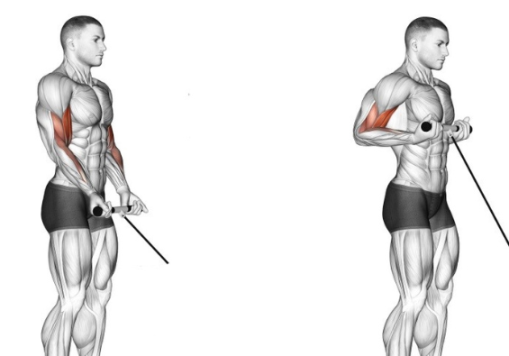
How To Do
- Stand with your feet shoulder-width apart and hold the resistance band with both hands.
- Keep your elbows tucked close to your body and start the movement by dragging the band upward along your torso. Think of pulling your elbows back and up.
- As you reach the top of the movement, pause and squeeze your biceps, feeling the contraction.
- Slowly lower the band back down to the starting position.
6. Resistance Band Seated Row
Seated Rows with Resistance Bands primarily target the traps, latissimus dorsi, rhomboids, rear delts, and biceps. It will also work your erector spinae, as you need your lower back to stabilize your movement.
Resistance bands are easy to carry and use so that you can do seated rows almost anywhere.
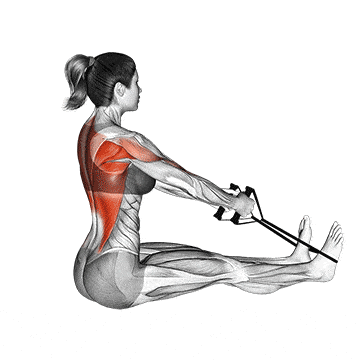
How To Do
- Sit on the floor with your legs extended. Loop the resistance band around the soles of your feet and hold one end in each hand.
- Maintain your legs extended with just a slight bend in the knee, and keep your shoulders back.
- Keep your posture erect and your lower back slightly arched.
- Slowly pull the handles to your lower abdomen. Keep your elbows close to your sides.
- As the handles touch your body, squeeze your shoulder blades together.
- Then, reverse direction, slowly returning to the start position.
7. Band Assisted Pull Up
A band-assisted pull-up is a variation of the pull-up that uses a resistance band to help you lift your body weight. This makes it a great option for people not yet strong enough to do a regular pull-up.
It’s a great way to build up your upper body and strengthen your grip.

How To Do
- Secure the resistance band to a pull-up bar or other sturdy anchor point.
- Place one or both feet in the resistance band, depending on the level of assistance needed.
- Grasp the pull-up bar with an overhand grip, hands slightly wider than shoulder-width apart.
- Pull yourself up towards the bar by squeezing your shoulder blades.
- Pause at the top of the movement, then slowly lower yourself back to the starting position.
Know More: 150+ Workout Motivational Quotes (With Images)
At-Home Resistance Band Bicep Workout Plans
This workout consists of multiple band exercises designed to target all the muscles in your biceps and increase your overall arm size and strength.
This workout plan is a starting point that can be adjusted based on individual fitness levels and goals.
Band Bicep Training Plan
- For muscle endurance: 3–4 sets of 12–15 reps, with moderate resistance.
- For muscle hypertrophy (increased muscle size): 3–4 sets of 8–12 reps, with moderate to heavy resistance.
It is always best to start with fewer reps and sets and gradually increase them as your strength improves.
Furthermore, it is important to allow for adequate rest between sets, typically 60–90 seconds.
Band Bicep Workout Routine For Beginner
| Exercise | Sets | Reps | Rest |
|---|---|---|---|
| Band Bicep Curl | 3-4 | 8-10 | 60-90 sec |
| Band Hammer Curl | 3-4 | 8-10 | 60-90 sec |
| Seated Pull Up | 4 | 6-8 | 60-90 sec |
Band Workout Routine For Intermediate
| Exercise | Sets | Reps | Rest |
|---|---|---|---|
| Alternating Curl | 4 | 8-10 | 45-60 sec |
| Band Reverse Curl | 3-4 | 10-12 | 45-60 sec |
| Band Hammer Curl | 4 | 8-10 | 45-60 sec |
| Seated Band Row | 3 | 10-12 | 45-60 sec |
Conclusion
There’s a whole bunch of bicep exercises you can do with bands, so you’ll never get bored. Just pick the ones you like and stick with them. The key is to select a challenging band and perform 8-12 repetitions per exercise. In case of difficulty or ease, it is advisable to adjust the band accordingly.
Want those sculpted, powerful arms? Try adding band exercises to your routine 2-3 times a week.
Be consistent and focus on good form, and before you know it, you’ll be showing off those impressive biceps.
So grab a band and get curling—your arms will thank you.
Know More Resistance Band Exercises
- Best Resistance Band Chest Exercises
- Resistance Band Back Workouts
- Best Resistance Band Shoulder Exercises
- Resistance Band Trap Exercises
- Best Resistance Band Tricep Exercises
References
- 1. Lopes JSS, Machado AF, Micheletti JK, de Almeida AC, Cavina AP, Pastre CM. Effects of training with elastic resistance versus conventional resistance on muscular strength: A systematic review and meta-analysis [published correction appears in SAGE Open Med. 2020 Sep 9;8:2050312120961220]. SAGE Open Med. 2019;7:2050312119831116. Published 2019 Feb 19. doi:10.1177/2050312119831116
- 2. Bergquist R, Iversen V, Mork P, Fimland M. Muscle Activity in Upper-Body Single-Joint Resistance Exercises with Elastic Resistance Bands vs. Free Weights. Journal of Human Kinetics. 2018;61(1): 5-13. https://doi.org/10.1515/hukin-2017-0137.
- Coratella, G.; Tornatore, G.; Longo, S.; Toninelli, N.; Padovan, R.; Esposito, F.; Cè, E. Biceps Brachii and Brachioradialis Excitation in Biceps Curl Exercise: Different Handgrips, Different Synergy. Sports 2023, 11(3), 64. https://doi.org/10.3390/sports11030064

Manish is a NASM-certified fitness and nutrition coach with over 10 years of experience in weight lifting and fat loss fitness coaching. He specializes in gym-based training and has a lot of knowledge about exercise, lifting technique, biomechanics, and more.
Through “Fit Life Regime,” he generously shares the insights he’s gained over a decade in the field. His goal is to equip others with the knowledge to start their own fitness journey.
